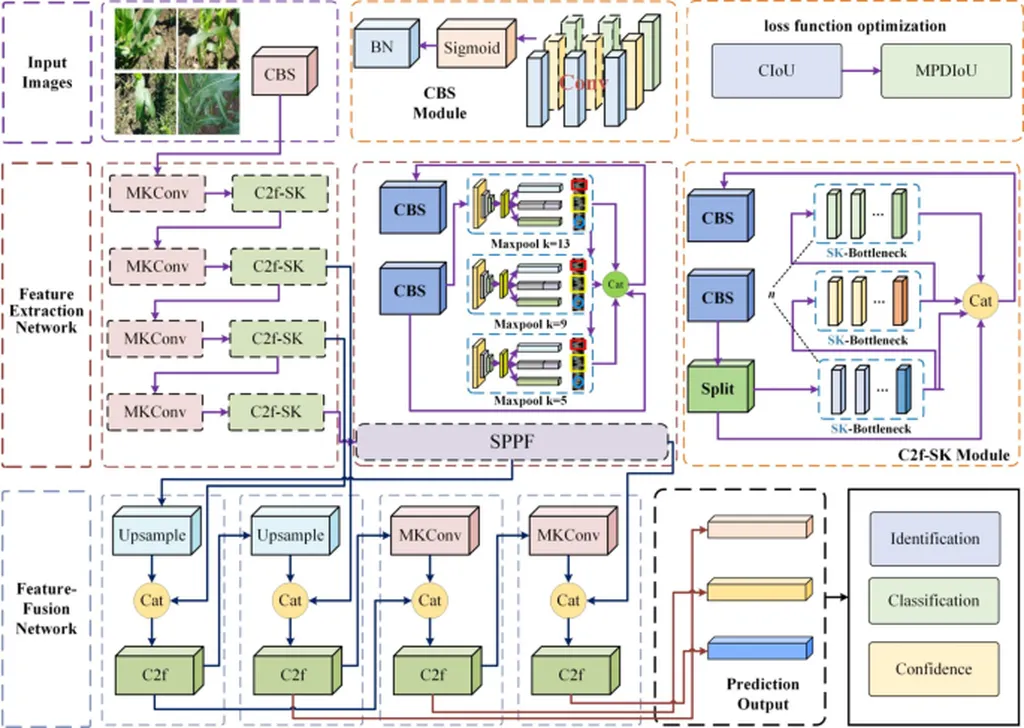In the relentless pursuit of safeguarding maize crops, a team of researchers led by Yijie Ren from the State Key Laboratory of Smart Farm Technologies and Systems at Northeast Agricultural University has made a significant stride. Their work, published in the journal *Agriculture* (translated from Chinese), introduces a novel deep learning model that promises to revolutionize the detection of pathogenic fungal spores in maize. This advancement could have profound implications for the agricultural sector, particularly in the fight against devastating diseases like northern corn leaf blight, corn head smut, and corn rust.
The challenge of detecting fungal spores in maize has long been a formidable one. Traditional methods often fall short when it comes to identifying spore-level targets within the complex backgrounds of agricultural environments. Recognizing this gap, Ren and his team set out to enhance the recognition accuracy of various maize disease spores. Their solution? The YOLOv8s-SPM model, a sophisticated integration of cutting-edge technologies designed to improve spore detection.
The YOLOv8s-SPM model incorporates several innovative components. First, the team introduced the space-to-depth and convolution (SPD-Conv) layers into the backbone of the YOLOv8s model. This enhancement significantly boosts the model’s ability to recognize small targets and low-resolution images, which are common in spore detection. “By improving the model’s performance on small targets, we can ensure that even the tiniest spores are not overlooked,” Ren explained.
To further optimize the model, the researchers integrated the Partial Self-Attention (PSA) mechanism within the Neck layer. This addition not only improves computational efficiency but also enhances the model’s ability to focus on relevant features within the image. The final touch was the application of the Minimum Point Distance Intersection over Union (MPDIoU) loss function, which refines the localization performance of bounding boxes, ensuring precise identification of spores.
The results speak for themselves. The YOLOv8s-SPM model achieved an impressive 98.9% accuracy on the mixed spore dataset, outperforming the baseline YOLOv8s model by 1.4%. This significant improvement in accuracy translates to more reliable and timely detection of pathogenic spores, which is crucial for early intervention and disease management.
The implications of this research extend far beyond the laboratory. In the agricultural sector, timely detection of fungal spores can mean the difference between a bountiful harvest and a devastating crop loss. By providing a more accurate and efficient means of spore detection, the YOLOv8s-SPM model offers farmers and agricultural professionals a powerful tool in their arsenal against maize diseases.
Moreover, the model’s superior performance under complex background conditions makes it particularly valuable in real-world agricultural settings. “Our model is designed to handle the challenges of real-world environments, where backgrounds can be cluttered and conditions can vary widely,” Ren noted. This robustness ensures that the model can be effectively deployed in diverse agricultural contexts, from large-scale farms to small-scale operations.
Looking ahead, this research opens up new avenues for future developments in the field of intelligent spore recognition. The YOLOv8s-SPM model sets a high standard for accuracy and efficiency, paving the way for further innovations in agricultural technology. As the agricultural sector continues to embrace digital transformation, tools like the YOLOv8s-SPM model will play a crucial role in enhancing productivity, sustainability, and resilience.
In conclusion, the work of Yijie Ren and his team represents a significant leap forward in the fight against maize diseases. By leveraging the power of deep learning, they have developed a model that not only meets the demands for high-precision spore detection but also offers a practical path for future research. As the agricultural sector continues to evolve, the YOLOv8s-SPM model stands as a testament to the potential of technology to transform and improve the way we grow and protect our crops.

